Kraków 2007-08-22
235 Section 1974-04-26
OKB Suchoj Su-20
Poland
History
Supersonic fighter-bomber plane, with variable-sweep wing (variable wing geometry). The first of its kind in the Polish Army (Polish Air Forces).
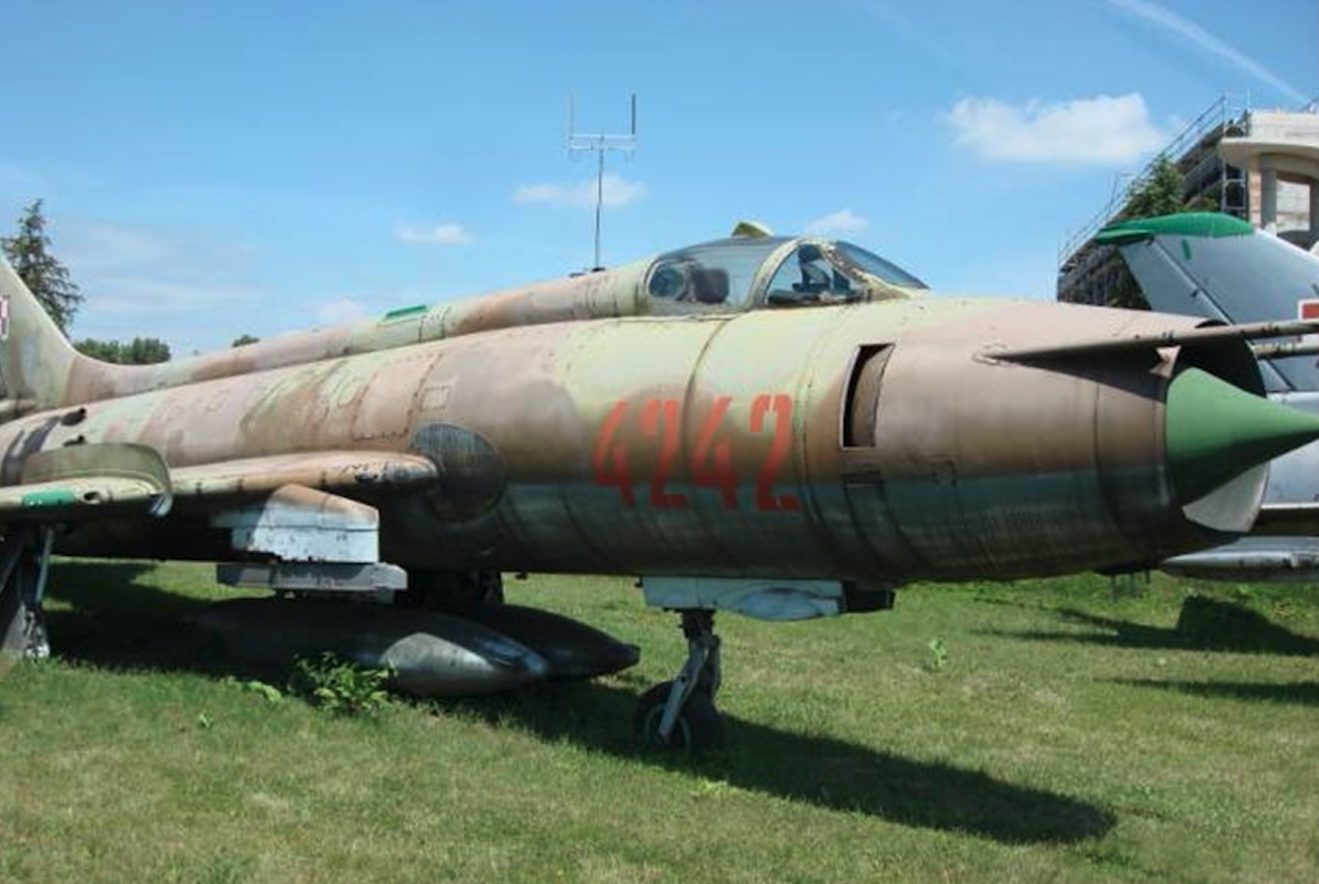
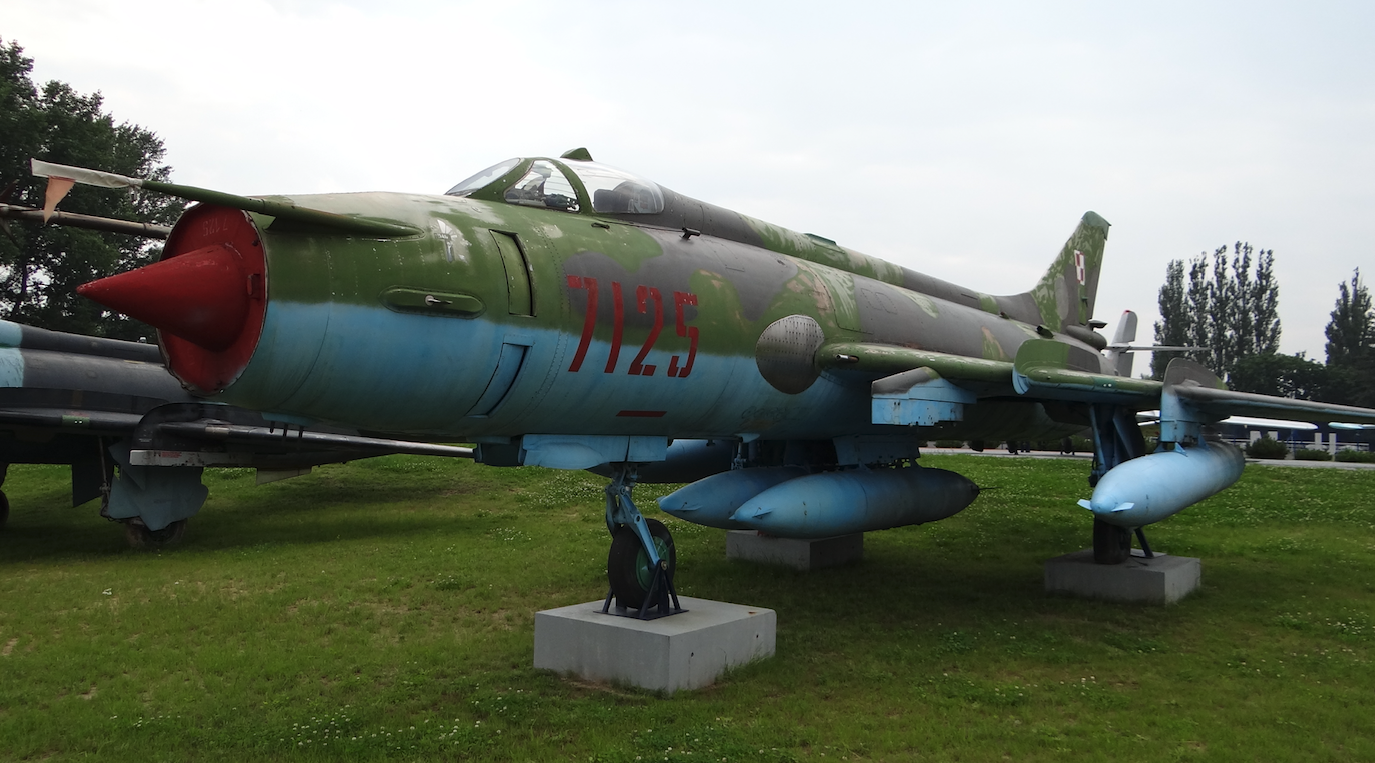
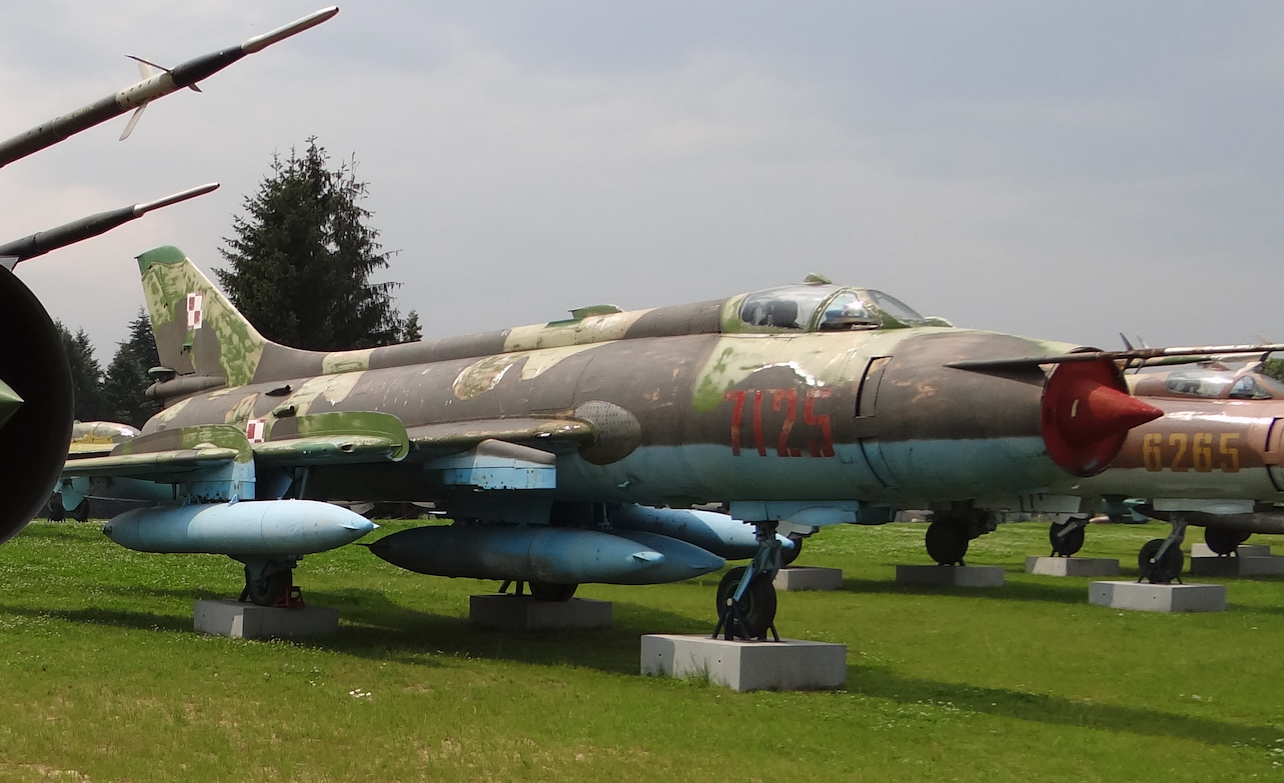
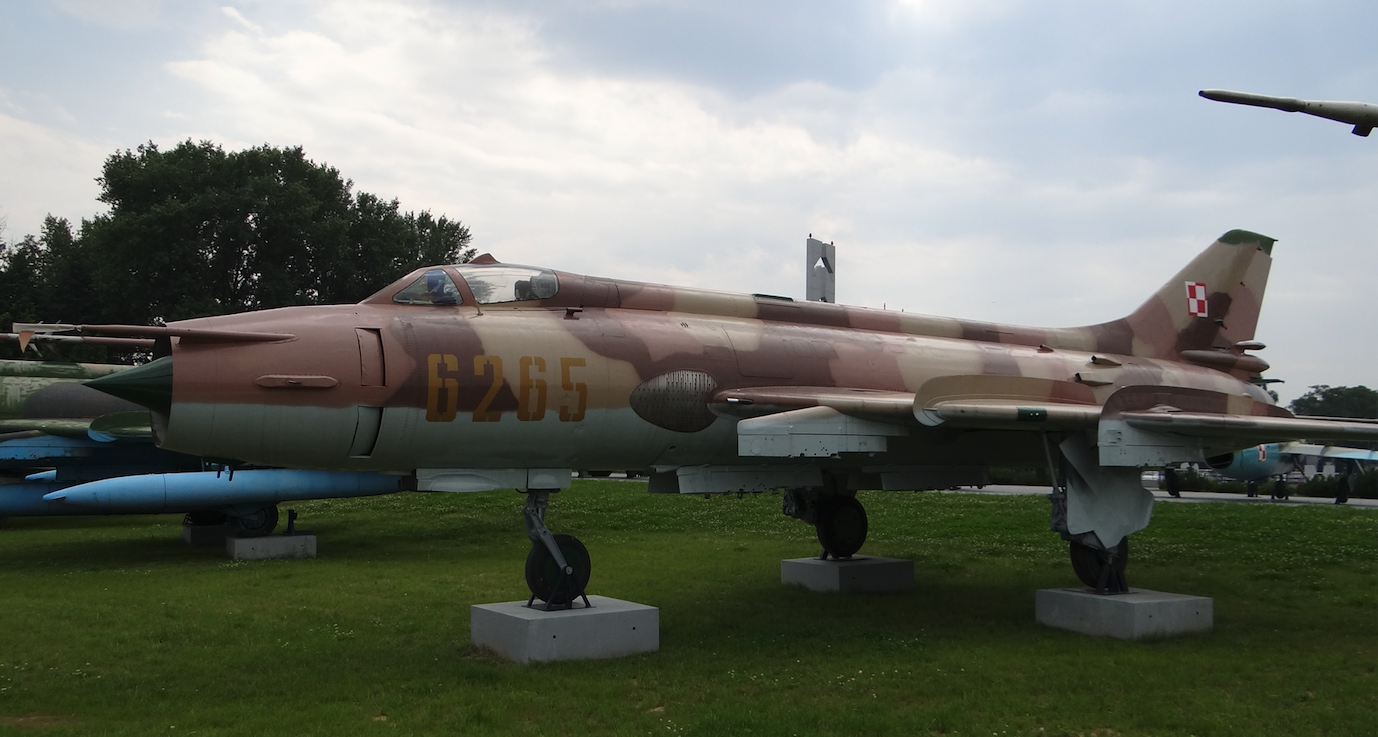

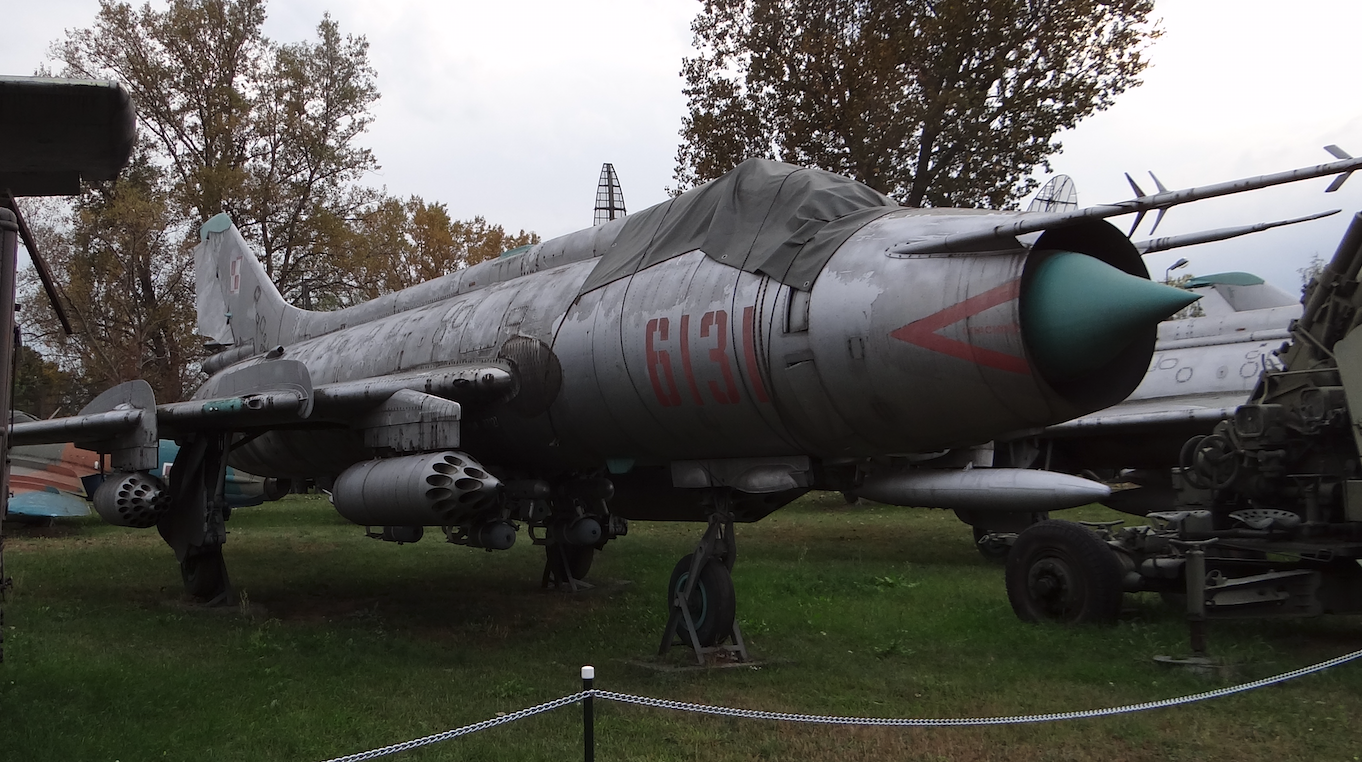
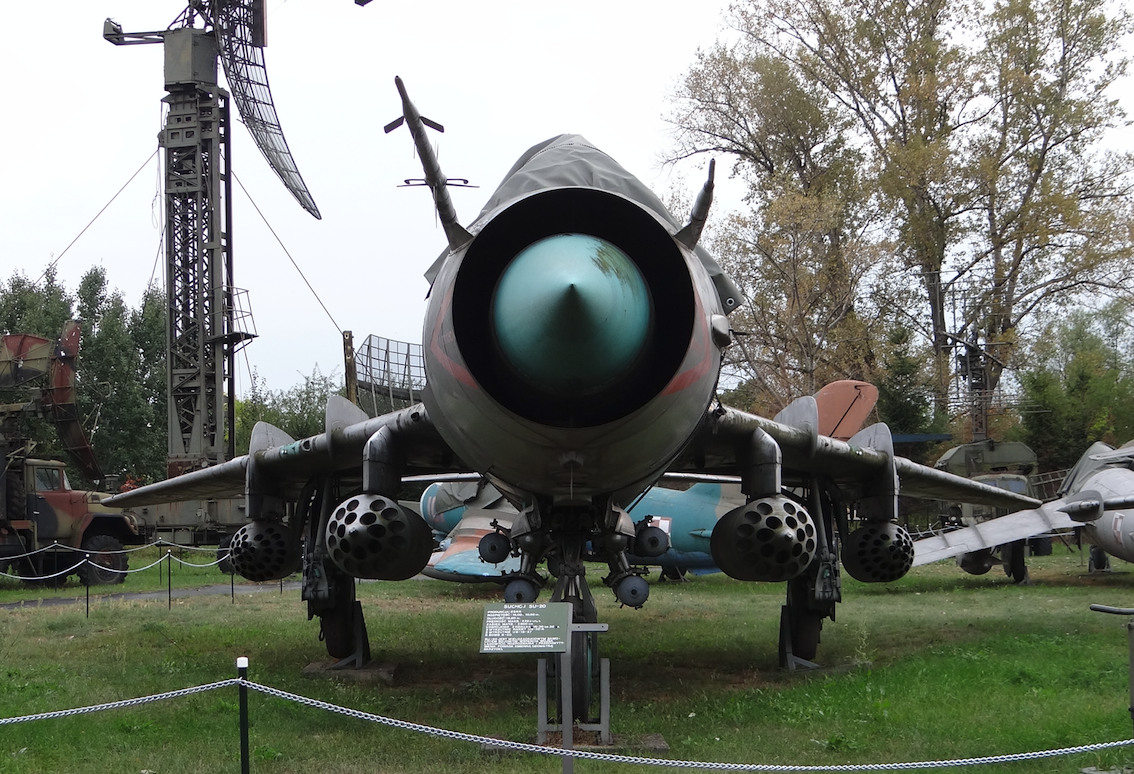
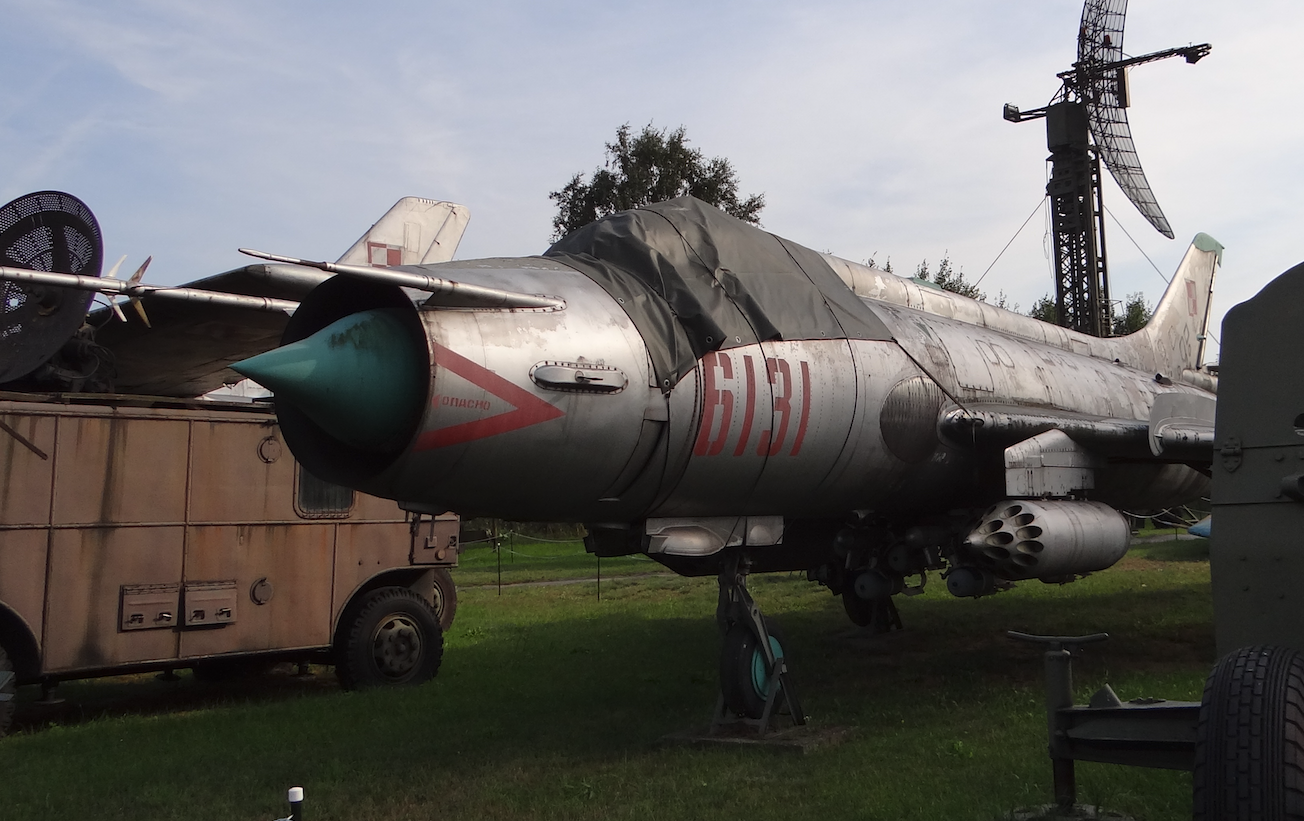
History
The variable-sweep wing.
Before we start discussing the Su-20 (Su-17) aircraft, let’s move to the famous parade in Domadiedów on 1967-07-09. The parade was famous because it was the 50th anniversary of the October Revolution.
… The next three take-off planes were arranged in one string, with gradation of attractiveness. First, W. Kriżanowski started on Su-7 BM. Behind him A. Poltaranow, on a Su-7 BKŁ plane. The aircraft has additional solid-fuel start engines, thanks to which the take-off was much shorter. Another aircraft from the Su-7 family takes off as the third. He sits behind the old. K. Kukuszew. The start is as short as before, but no additional engines are seen. It is only in the air that the viewers notice that the plane has unusual wings. Their tips are movable. During the start they were widely spread. In flight, the pilot changes the geometry of the wings several times and then lands. The show commentator reported that this is the first Soviet aircraft with variable wing geometry. It was only after some time that we learned that it was a plane bearing the designation S-22 I, or Su-7 IG (izmiennaja geometrija).
At the beginning of the 1960s, OKB Suchoja began studies on the variable geometry of the wings. The work went slowly. At the turn of 1964 and 1965, Soviet intelligence began to provide information about the new American TFX (F-111). At that time, Americans already had considerable experience in the construction of aircraft with variable wing geometry. Recall; X-5 and Grumman XF-10 F-1 Jaguar. At that time, the Soviet authorities decided to finance this course of work at OKB Sukhoi and ordered work in parallel at OKB Mikojan and Guriewicz on the MiG-23 aircraft.
In OKB Suchoj it was decided to use variable geometry in the Su-7, or S-22 aircraft. This was dictated by the specificity of fighter-bomber operations. It has been found that there is a need to improve the flight characteristics at low speed.
The works went towards the reconstruction of the wing itself, without changing its location towards the fuselage. In May 1965, Paweł Osipowicz Suchoj, together with the head of the office design brigade, A. M. Poliakowy, working with CAGI, where the work was conducted by P. P. Krasilszczikow, presented the concept of the wing. They were divided into two parts. The part near the hull remained stationary. This allowed for; leaving the main landing gear without major changes, shooting equipment and weapon knots in their current location. Leaving a significant part of the wings still had the advantage that the displacement of the center of pressure was small and in the whole change of the skew angle was only 2% ŚCA. The movable part of the wings has a length of 4 m. In addition to the ailerons, it also has flaps that can be used only with a minimum skew of the wings. Extensive slots (front flaps) were mounted on the leading edge, which resulted in improved aircraft maneuverability by increasing the permissible angle of attack from 17 degrees to 22 degrees. There was also space for internal fuel tanks. Changing the angle of the wings is done in the range of 30 degrees to 63 degrees.
A 400 kg increase in wing weight and less fuel in the wings would indicate that the flight range will be reduced. However, tunnel tunnel wing studies have shown that in intermediate positions, close to 45 degrees, the range will even increase somewhat.
The wings are moved by means of two independent hydraulic installations connected by a synchronizer. Failure of one installation only reduces the speed of rotation.
S-22 I (Su-7 IG). 1966.
Work on the S-22 I (Su-7 IG) (change geometry) began in full swing in May 1965. The group was headed by Nikojał Gieorgijewicz Zyrin. The Su-7 BM used to date in the office for test flights was chosen as the starting point. The back of the hull came from Su-7 BKŁ and a new lobe was mounted on such a hybrid.
The reconstruction of the aircraft lasted from January to July 1966. After ground tests, the first flight was approved. The first flight of the S-22 I (Su-7 IG) was performed by Vladimir S. Iliuszyn on 1966-08-02. In this way, he became the first Soviet aircraft with variable wing geometry. Already in the first flight the pilot changed the geometry. The pilot found a slight moment to dive or climb paired with small movements of the joystick. After 20 minutes, the machine landed in the airport Żukowski. The plane was flying very intensively and smoothly. Tests have shown a significant improvement in low speed and altitude flight performance and no deterioration in high speed flight performance.
The new AL-21 engine developed in CCCP.
As a result of the war in Vietnam, many components of General Electric J 79 engines were introduced to the CCCP. The Soviets decided to use this and create a motor enabling the rapid increase in the air performance of Soviet combat aircraft, including the Su-17 aircraft. Work on the engine marked AL-21 F engineer A. M. Lulka has been running since 1965. The initial engine model was to develop a maximum thrust with 1 x 87.25 kN afterburning, and its first prototype was ready for testing in 1966. From 1968, subsequent AL-21 F engines went to the Su-24 prototypes.
The engine had several disadvantages, so in 1969, a decision was made to comprehensively upgrade the engine. The work was carried out until March 1970. AL.-21 F 3 engine was developed. The new engine received a larger compressor. The reliability increased, the resurs were extended and the string 1 x 76.48 kN was obtained, with the afterburning 1 x 109.80 kN. The engine was adapted for flights at low altitudes.
In the first period of development and operation of the AL.-21 F 3 engine, high-temperature titanium fires were a big problem. Finally, in 1974, the engine successfully passed state tests and was allowed to operate without major restrictions.
S-32 M / Su-17 M. 1971
The new, smaller, lighter and stronger engine (still one-flow) caused a thorough reconstruction of the Su-17 aircraft fuselage. The characteristic waist has disappeared. The diameter of the fuselage decreased from 1.64 m to 1.55 m. Changed the engine cooling grip space. The exploitation gaps have been re-located. The fuel system has a volume of 3 640 kg of kerosene. The wing synchroniser has been refined, simplifying its construction by giving up cardan connections. The engine allowed to increase the lifting capacity up to 4,000 kg. That is why two more attachment points have been added, under the fuselage, with a capacity of 500 kg. To shorten the landing time of the aircraft when landing, one new cross-shaped parachute with an area of 25 m2 was used, and the container was reduced.
Equipment has also been modernized. The RSBN-2 S close-navigation system was replaced by the RSBN-5 S. The new ARK-15 M. radiocomposite. A set of Pion-GT-32 antennas was moved from the top towards the rudder.
All these changes did not increase the weight of the plane, on the contrary, the plane is lighter by 200 kg.
After the application of the new AL.-21 F 3 engine with 1 x 76.48 kN, and with the afterburning 1 x 109.80 kN, a new version of the aircraft was marked S-32 M (S-34). Two prototypes marked S-32 M-1 and S-32 M-2 were built. The first prototype made the first flight with pilot Je. S. Sołowiew in December 1971. Probably 1971-12-05. The factory trials were carried out quickly and both planes went to state tests.
The new engine improved the aircraft’s performance. In comparison with the Su-7 B, the lifting capacity has doubled, reaching 4,000 kg, and the take-off and landing distance has been halved. In comparison to the Su-17, the range increased depending on the amount of fuel taken, within 145-165%.
In July 1972, a copy of the S-32 M-1 was lost. It was broken by one of the military pilots during the familiarization flight. In the army, the plane was marked Su-17 M. It was initially adopted as armament in 1973, and finally in November 1974. Production was carried out in the period 1971-1975, in series "51-61 and 67-73". The first aircraft went on armament in 1972, mainly to the European part of CCCP, including sea aviation. In total, 253 machines were built.
Production of Su-17 and Su-17 M for some time went in parallel, therefore some changes were introduced simultaneously on both variants. For example, the first Su-17 M did not have a second pair of aerodynamic steering wheels on the center wing. The emergency air pressure receiver was still on the side, not on the boom. The angle of attack was missing. The same was with armaments. Changes were introduced gradually during renovations.
In the peak period of aircraft production, a missile anti-radaroy Ch-28 missile was introduced. It is a large projectile carried under the fuselage on the PU-28 S central beam. Detection and indication of the purpose of the passive homing head was provided by the Mieteł-A apparatus. It is carried in the tray on the right beam under the sash.
A new type of suspended fuel tanks PTB-800 was introduced to make armament variants more flexible. Fuel can be refueled with a central valve located on the fuselage’s back.
The Su-7 BMK with variable-sweep wing for export. 1973
The decision to direct a modern aircraft for export was not easy. Originally, the Su-7 BMK was planned to be equipped with modified wings. Enable him to carry 4,000 kg of cargo on 8 points; two under the fuselage, six under the wings. In the wings it was planned to increase the capacity of tanks by 330 kg. The plane was to be able to take additional tanks also under the wings. These were to be PTB-1500 tanks. In 1973, the prototype of the aircraft made the first flight piloted by W. A. Kreczetow. But unexpectedly, work on this plane was discontinued.
The Su-20 (Su-17 MK). 1972
According to plans, in February 1972, the Su-17 M export variety was designated Su-17 MK (Kommerczieskij). The prototype took off on 1972-12-15, piloted by A. Isakov. The aircraft in the period January-December 1973, successfully passed state tests and was directed to serial production. The first deliveries to the Middle East arrived in the first months of 1973, because the war, later called "October", had just begun. The production was carried out in the years 1972-1976 and covered the number 136 copies in series "62-66 and 74-76". Airplanes were exported to Egypt, Iraq, Poland and Syria.
From the air inlet cone to the engine, Delta-N radio-command equipment was dismantled, and the SRD-5 MK radio and rangefinder was mounted in its place, with the possibility of cooperating with infrared projectiles: R-3 / R-13, up to 4 copies on beams sub-wings type APU-13 M. The Delta-NG apparatus was placed in the gondola under the right point of armament fixing. In the armament appeared the UPK-23-250 shooting gondolas with a GSz-23 machine gun with a supply of 250 rounds. The missiles Ch-28, S-8 and S-25 were abandoned.
The use of Su-17, Su-20 aircraft.
The use of Su-17 and Su-20 planes significantly limited weather conditions. A low cloud base or poor visibility, with a very simple navigation system, often prevented the task from being completed. Su-17 and Su-17 MK aircraft could be brought closer to the target area with some approximation, but its search and attack had to be performed under visual visibility conditions.
The Su-20 R
In the mid-1970s, the KKR-1 reconnaissance containers (kontejner kompleksnoj razwiedki) were introduced for Su-20 (export) aircraft. The tray has dimensions; length 6.79 m, width 0.59 m, height 0.58 m, and with beam 0.715 m, weight 780 kg. It is carried centrally under the fuselage.
The KKR-1 enables vertical, perspective and panoramic shooting of terrain from small and medium altitudes in day conditions and from low altitudes in night conditions as well as general radio-electronic recognition from any ceiling, at any time of day or night in "all weather conditions".
The KKR-1 consists of; AFA-39 camera (for vertical and perspective photos), PA-1 (panoramic), UA-47 (vertical at night), flashlight ejector SFP-2 A, 4 KDF-38 cartridges with FP-100 flashcards, block BZ pulses delaying the production of signals for the opening of the camera shutter UA-47, electronic recognition stations SRS-9 Wiraż. Cooling system using freon.
The Su-20 R with a KKR-1 container has a starting mass of 15 610 kg, the maximum speed depending on the altitude of 1 300 – 1 800 km / h. Range at a height of 200 m – 735 km or with two reservoirs PTB-1 150 – 1 150 km. And the range at an altitude of 10,000 m respectively 1 400 km and 2 050 km. The permissible overload of the aircraft in flight is 5g. Later on, the KKR-1 container was also installed on Su-22 airplanes.
Prologue for the introduction of the Su-20 aircraft on the armament of Polish Military Aviation (Polish Air Forces).
Before we discuss Polish Su-20 planes, move to Defilad Square in Warsaw on 1974-07-22.
… The gathered people around Plac Defilad, on the occasion of the Communist holiday on 22 July, at a certain moment, turned their heads towards the Saski Garden. Against the background of the blue sky, five microscopic points from second to second transformed into characteristic silhouettes. As they approached the capital, their speed increased. The five jets with high acceleration from horizontal flight entered the vertical flight, leaving behind exhaust fumes. Subsequently, the change of the wing geometry was demonstrated. These planes were the first in the Polish Army fighter-bomber machines with variable-sweep wing, the Su-20. These planes aroused great interest and brought at the same time another evolution in the Polish Aviation.
The Su-20s aircraft were also shown on television, in July 1974, in a short film showing preparations for the July parade. The machines flying in a row demonstrated a way to change the angle of the wings. Even then, it could be observed that the change in the skew angle takes about 15 seconds.
Years later, we learned that pilots were on this flight; captain pilot Alexander Zielenow, lieutenant pilot Ignacy Urbaniak, lieutenant Jerzy Doliniec, captain pilot Mieczysław Kafel, captain pilot Stanisław Walczak, and reserve pilot lieutenant Bogdan Likus.
The purchase history of the Su-20 for Poland.
At the beginning of the 70’s, Polish politicians and military began looking for the successor of Ił-28 bomb aircraft. The last 6 copies of Ił-28 bombers were removed from the state in 1979, but in fact the whole decade did not constitute any fighting value. CCCP offered us MiG-23 BN or Su-20 planes. Both planes with variable wing geometry. Offers were analyzed in terms of their suitability in our aviation. None of the offered aircraft, according to Polish specialists did not meet our requirements. But there was no other alternative. The choice fell on the Su-20, as a cheaper machine and to a large extent similar to the Su-7 aircraft of various varieties already used in Poland.
Deliveries the Su-20s
In the first days of 1974, a group of pilots and technicians left for Krasnodar to train for a new type of aircraft. Among the pilots were: Major pilot Maciej Paszkowski – commander of the 7th Regiment of Bomb and Reconnaissance Aviation from Powidz in 1974-1975, lieutenant pilot Bogdan Lis, captain Tadeusz Kołodziejczyk and others. It was them who were the first to make independent flights at Su-20 in Krasnodar. Due to poor weather conditions, the training was prolonged. During this training during the flight on Su-20 killed Capt. pil. Tadeusz Kołodziejczyk.
The first 6 copies of Su-20 were delivered to Poland in 1974. On 1974-04-26, planes landed at the airport in Powidz. These aircraft received side numbers from 01 to 06, painted in red. Of course, it was shown to the public during the parade in Warsaw 1974-07-22. We received the remaining planes only in 1976. In total, 25 items were bought. We did not buy the school-combat version, because the Su-7 U still played in this role.
Unfortunately, before the completion of the basic delivery of aircraft, on 1976-02-03, we lose the first Su-20 aircraft. The plane received nb 01. If the plane survived changes to the side numbers would receive nb 4241. Loss of pain, because the airman died, Maj. (Capt.) Pil. Jerzy Doliniec. The disaster took place near the village of Kazimierz Biskupi. The cause was a technical fault in the equipment. The engine has failed and it has stopped working. In addition, the whole power supply failed and there were problems with the aggregates. The failure occurred due to the fault of the producer, who acknowledged his guilt. Therefore, instead of the aircraft lost, the manufacturer delivered a new airplane (1977). We received the plane on 1977-02-12. The plane received nb 7125.
We received the remaining 19 Su-20 machines in the summer of 1976. These aircraft received four-digit side numbers originating from serial numbers, painted in red. At that time, the side numbers of the first 6 machines also changed.
Using the Su-20s in Poland.
In Poland, the Su-20 planes were dual-purpose machines. On the one hand, they were able to effectively attack the enemy’s objects on its territory, on the other hand they could conduct active photo and radioelectronics recognition during the day and at night. This second task was performed using a KKR-1 type tray. The tray were delivered to Poland later. It should not be forgotten that Su-20 aircraft used in Poland were potential carriers of tactical nuclear weapons.
The Su-20s aircraft made the first joint exercises in 1976, during maneuvers under the code name "Shield-76". The Su-20 planes were also operated from DOL (roadside airport sections) throughout their period of service in Poland.
In the 1980s, three Polish pilots saved the Su-20 planes from being destroyed, putting their lives at risk. On 1984-05-18, Captain Andrzej Pawul collided with the stork during the flight. The pilot suffered wounding the face with shards of glass and limited visibility. The pilot, however, managed to land safely. On 1985-09-04, Captain Krzysztof Ryniecki. After firing a heavy S-24 missile there was a motor pump and the engine went out. Despite the low flight altitude, the pilot managed to restart the engine and land safely at the airport. In 1988, the Su-20 plane with a pilot major Krzysztof Krzysztoforski was hit by a thunderbolt. The engine went out. The pilot restarted the engine and landed safely at the airport.
Information from 1990-10-16, about the Su-20 and Su-22 aircraft show for Swedish officers. – Su-20 used in Poland have excellent landing parameters. Captain Bogdan Juczyk is the master of the short landing. Before the touchdown, at a height of 2 m, the pilot releases the braking parachute. The measured run-out distance is only 350 m! At that time, the American attempts of the F-15 S / MTD aircraft gave a result of 450 m, without a braking parachute, and 380 m with the method used in Poland. The weight of the Su-20 aircraft landing is 11,000 kg, and the F-15 S / MTD aircraft – 13,000 kg.
The end of the Su-20 aircraft service
In the mid-90s, the number of machines began to decrease rapidly. Planes were crumbling due to the end of the airframe supplies. The end of exploitation came in February 1997, when the last machines were sent to Bydgoszcz for several months of maintenance (?), Followed by demolition. The last aircraft were removed from the list in 1998.
Written by Karol Placha Hetman
Kraków 2007-08-22
235 Section 1974-04-26
OKB Suchoj Su-20
Poland
Construction
Supersonic fighter-bomber plane, with variable-sweep wing (variable wing geometry). The first of its kind in the Polish Army (Polish Air Forces).
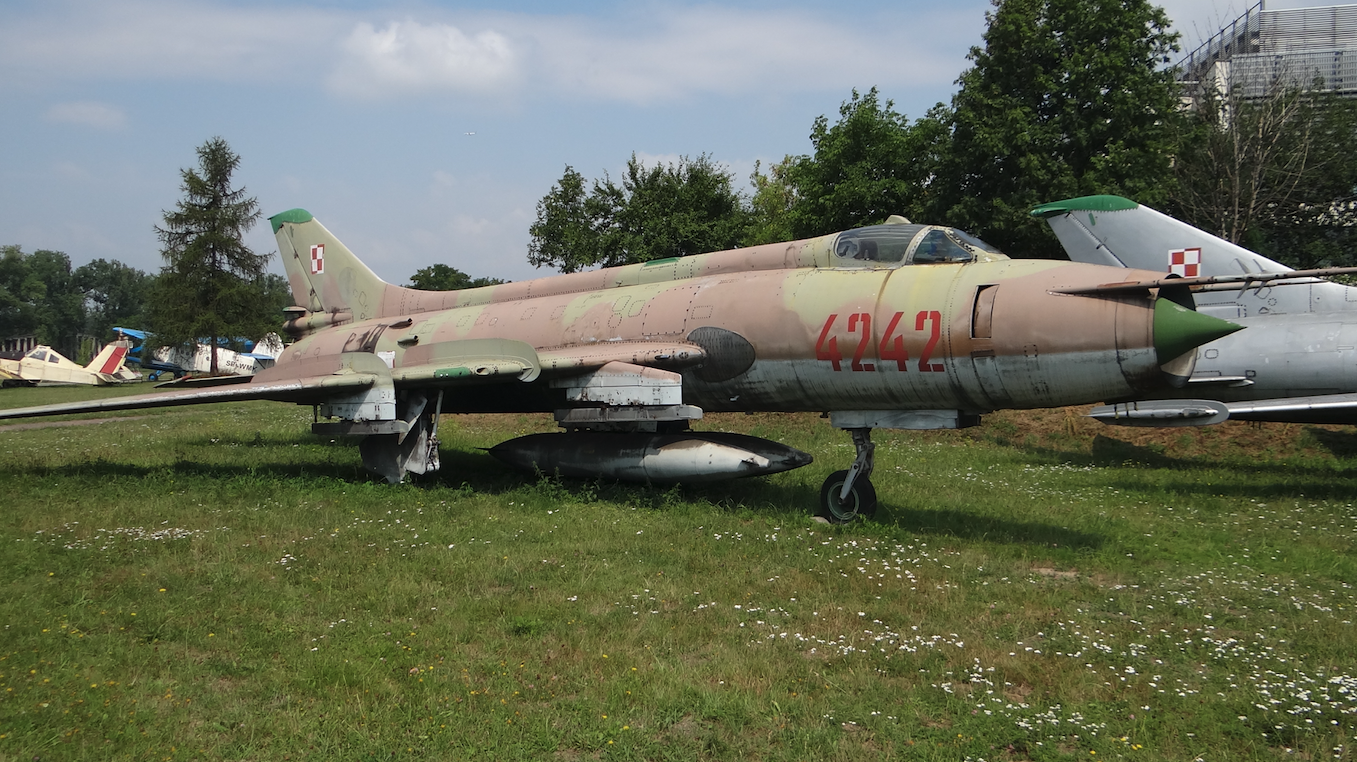
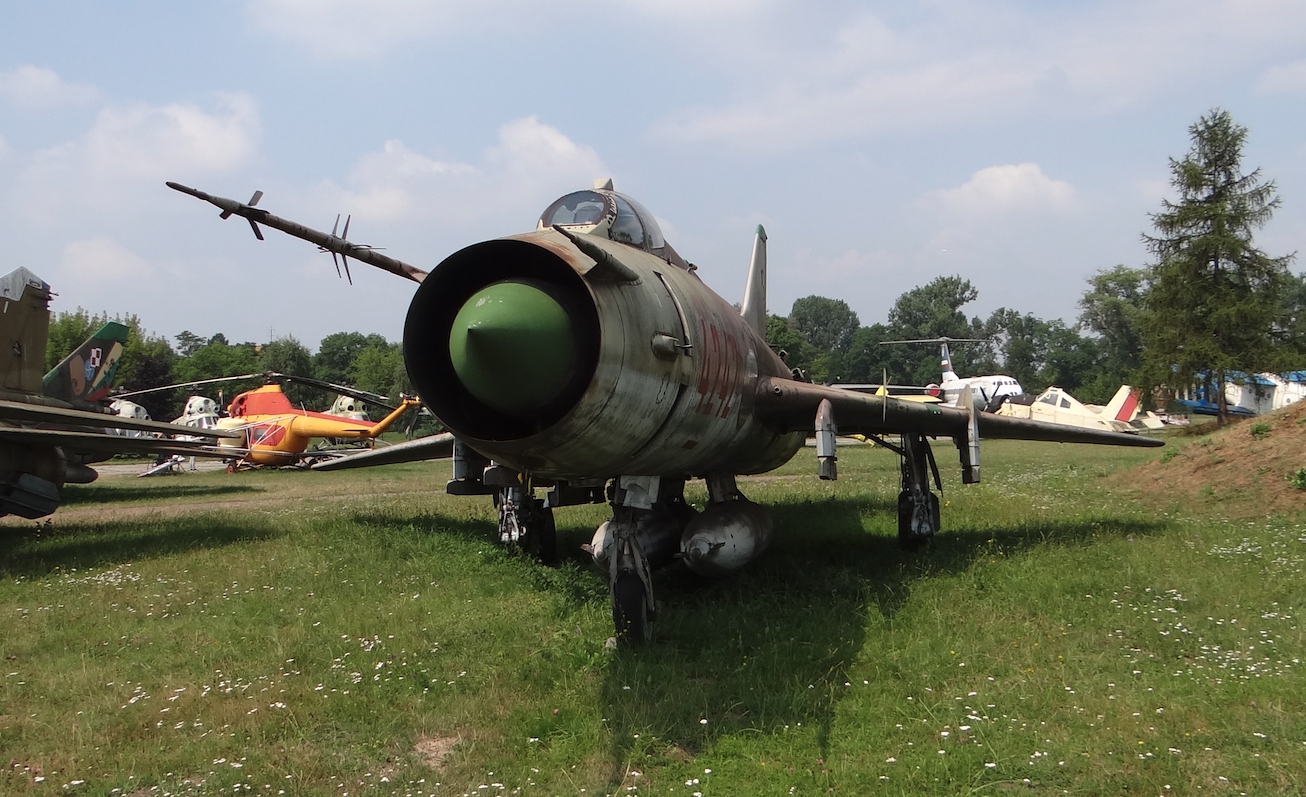
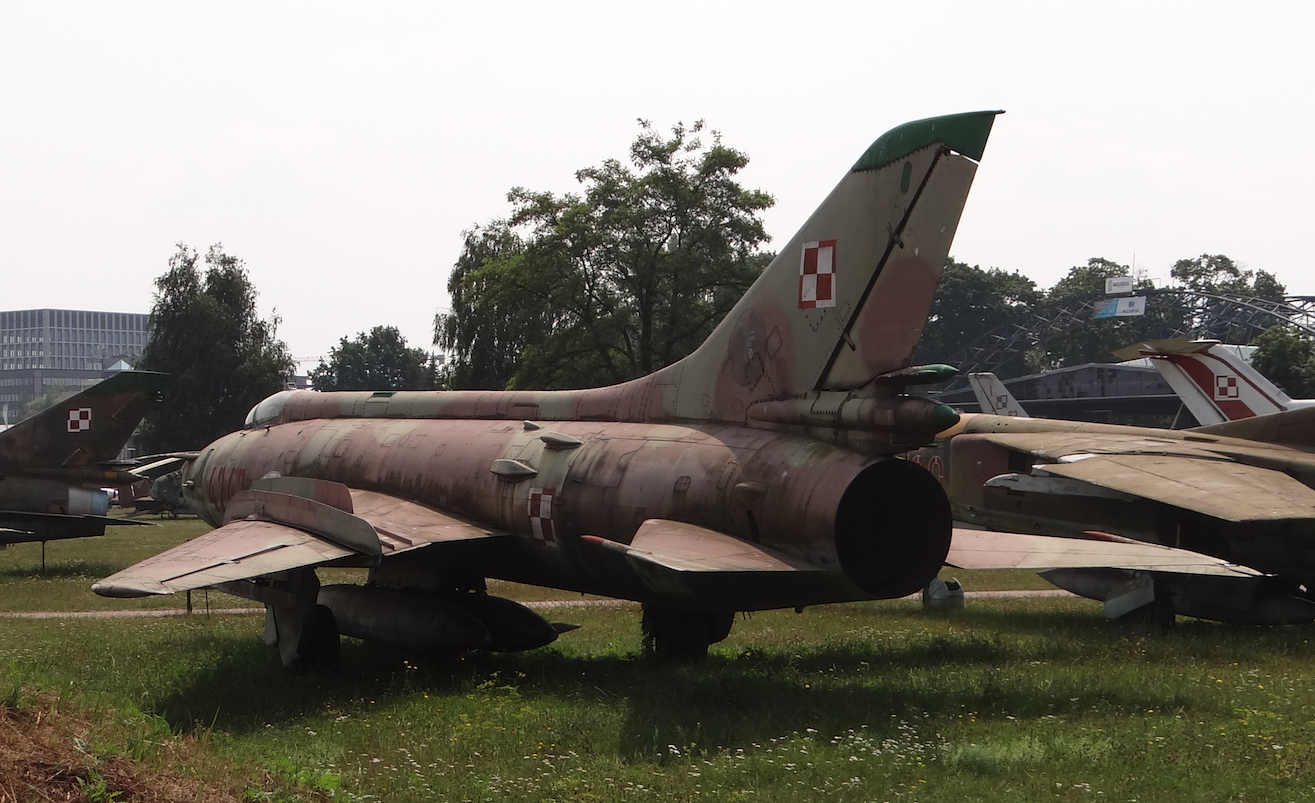
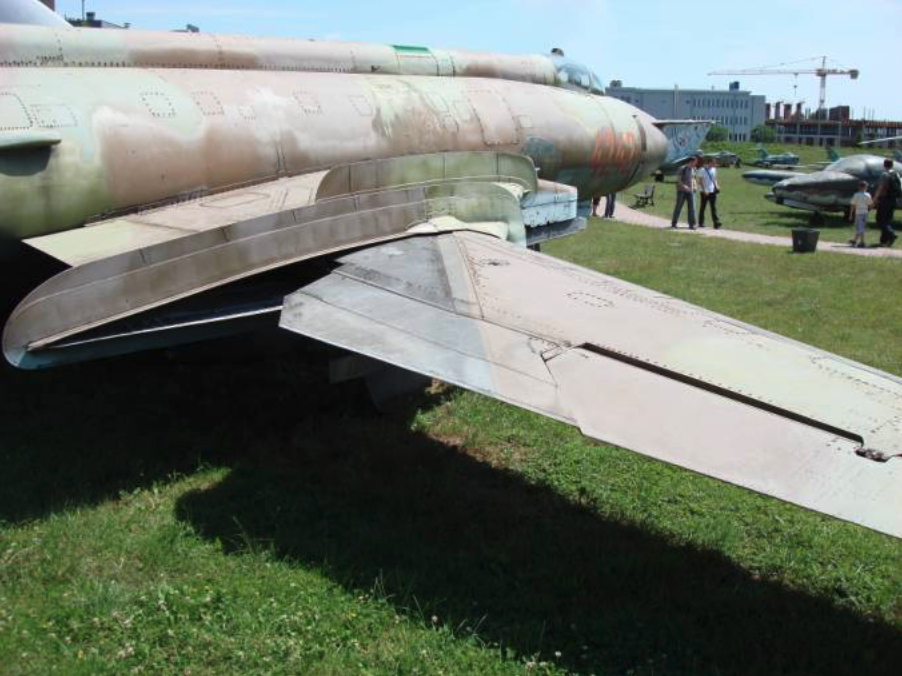
Construction Suchoj Su-20
Single-seat, single-engine fighter-bomber aircraft, supersonic, not equipped with a radar station. Built in a classic arrangement with a variable geometry wing. The fuselage is made of aluminum and titanium alloys.
The wings consist of a fixed part and external moving parts taking two positions. The minimum bevel angle of the wing is 30 degrees. The maximum angle is 63 degrees 03 minutes and 56 seconds. It is also the bevel angle of the stationary part of the wings. Both parts of the wing are hinged together. At the front is the pin with the bearing is the axis of rotation. At the back, the support is a four-wheel trolley, moving along the guides fixed inside the fixed part. The movement is carried out by a hydraulic system. The fixed parts are equipped with two-section slotted flaps on the runoff. The outer parts of the wings received ailerons and slotted flaps. Three-section gills (slots) were placed on the leading edge. The wing received 2 pairs of high aerodynamic steering wheels and 3 pairs of smaller aerodynamic steering wheels strengthening the construction of fixed parts of the wings. The wing cover was made by chemical etching. Control surfaces are made of 3-layer glued panels with beehive filler.
Circular fuselage. The maximum fuselage diameter is 1.55 m and the length is 15.347 m. The fuselage is technologically divided into two parts. Division is at the corner number 34. The removable rear fuselage allows access to the engine. A frontal air intake with a central inlet cone which can take two positions. Hermetic and air-conditioned pilot cabin. The cabin is located between frame 4 and 9. Throw chair KS-4 S-32, classes 0-140. It enables the pilot to safely leave the aircraft in the speed range from 140 km / h to 1,200 km / h. The cab cover is opened upwards backwards. A periscope was placed on the fairing to observe the rear zone. Armored windshield glass. Four aerodynamic brakes are located at the rear of the fuselage.
Horizontal plate tail formation with an angle of 55 degrees on 25% of the chord. The fixation is mounted with a negative rise of 3 degrees. Antiflatter masses were mounted on the ends. The swing is from +25 degrees 30 minutes to –10 degrees. Vertical tail formation divided into rudder and ballast. The skew is 55 degrees.
Three-support aircraft landing gear, with oil-pneumatic shock absorbers and hydraulic brakes. Steerable front wheel. The wheel dimensions are 660 x 200 mm, it is pulled forward into the chamber under the cabin floor. The main landing gear of the single-wheeled aircraft, dimensions 880 x 230 mm. The chassis base is 5.24 m, the main chassis spacing is 3.85 m.

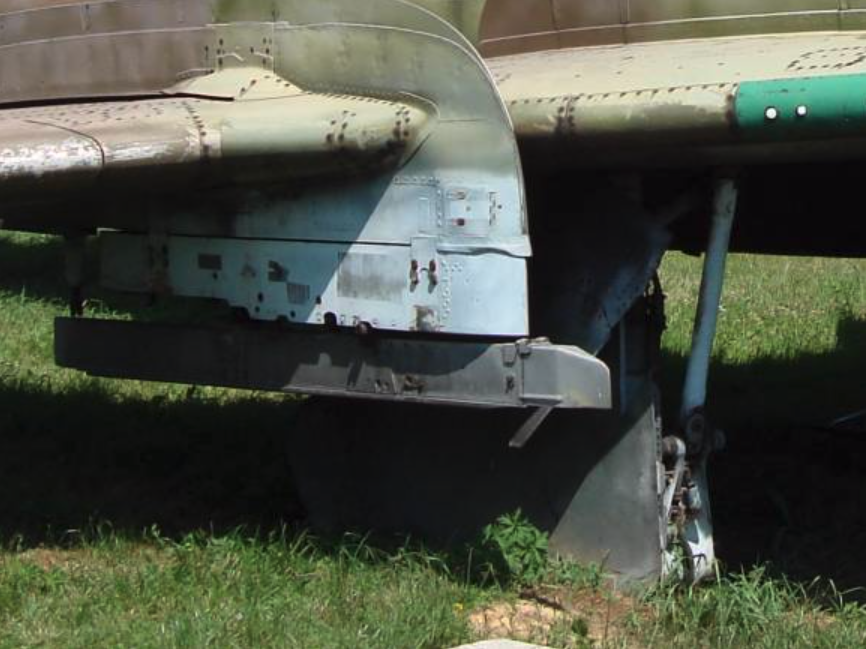
Aircraft propulsion
The A. Lulka AL.-21 F-3 engine with 1 x 76.50 kN thrust, and with afterburning 1 x 110.00 kN. This engine is specially designed for low altitude flights. It is a single-flow turbine composed of; 14-stage axial compressor, annular combustion chamber, 2-stage turbine and afterburner. The engine is cooled by air drawn by 4 catches located on the fuselage in the rear part.
The fuel is kerosene T-1, TS-1, RT. Oil IPM-10 or synthetic WNII-50. The fuel system consists of 4 tanks placed in the hull and two integral placed in the movable parts of the wings. In addition, the aircraft can carry 4 additional fuel tanks (2 under the fuselage and 2 under the wings).
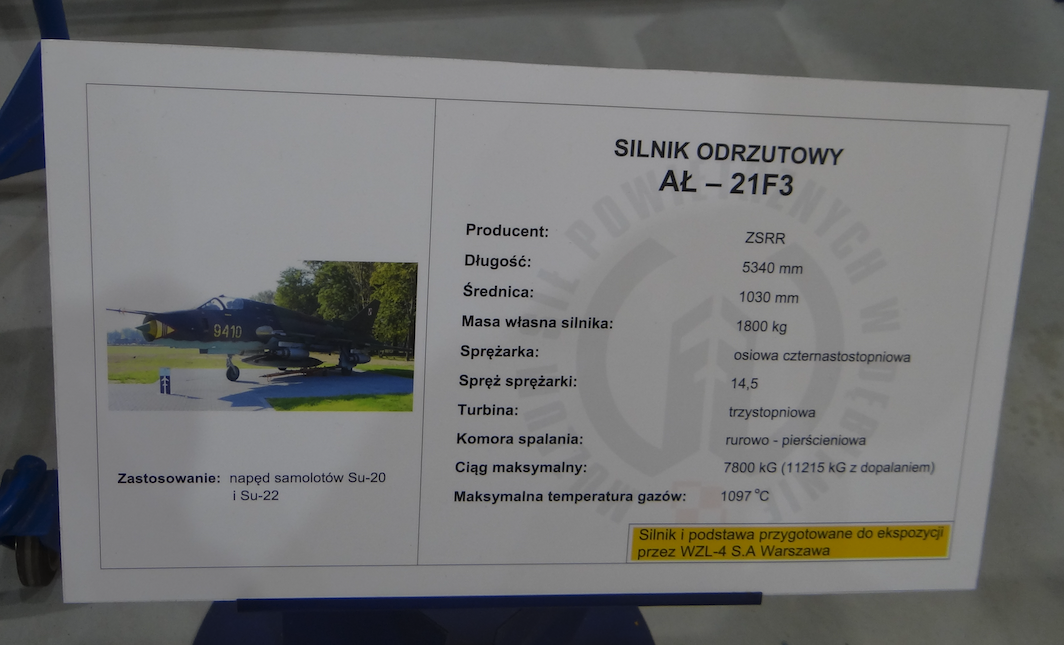
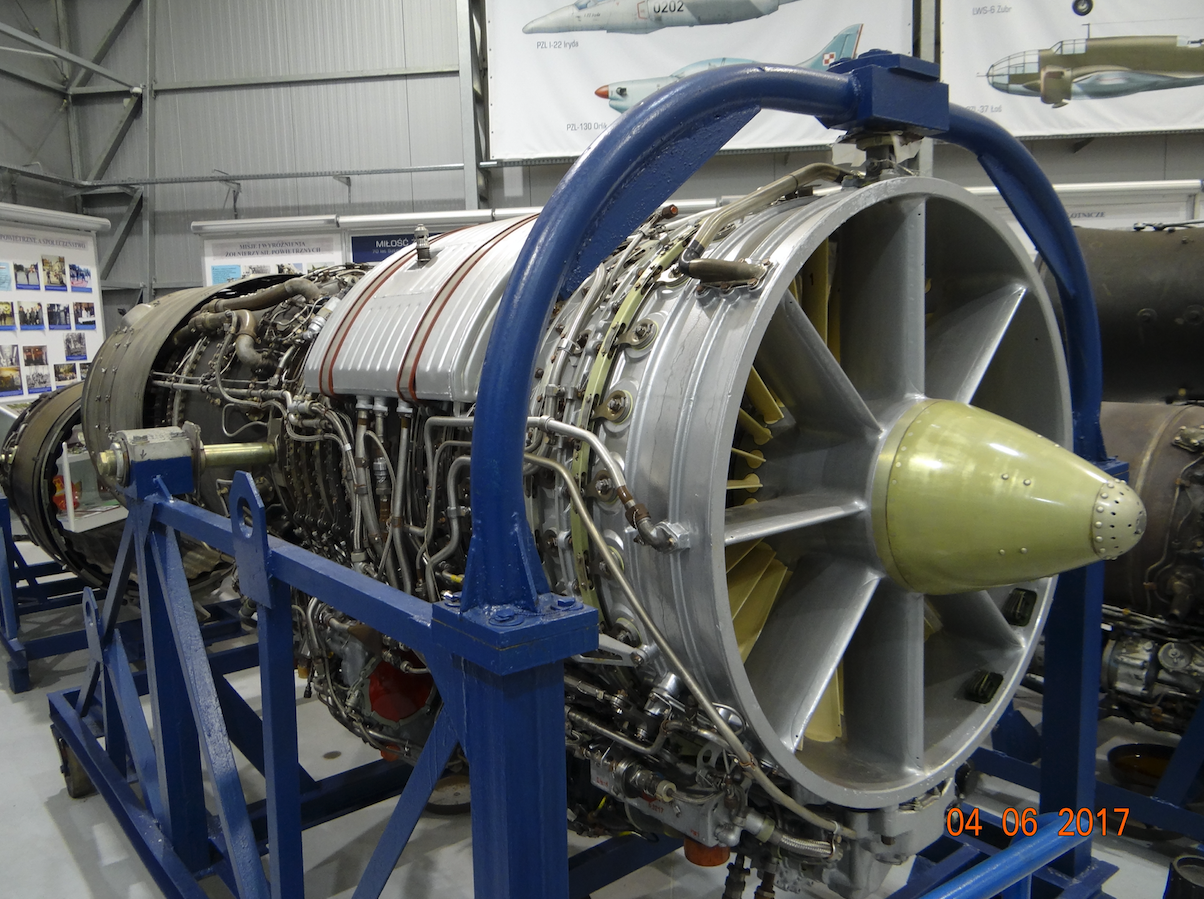
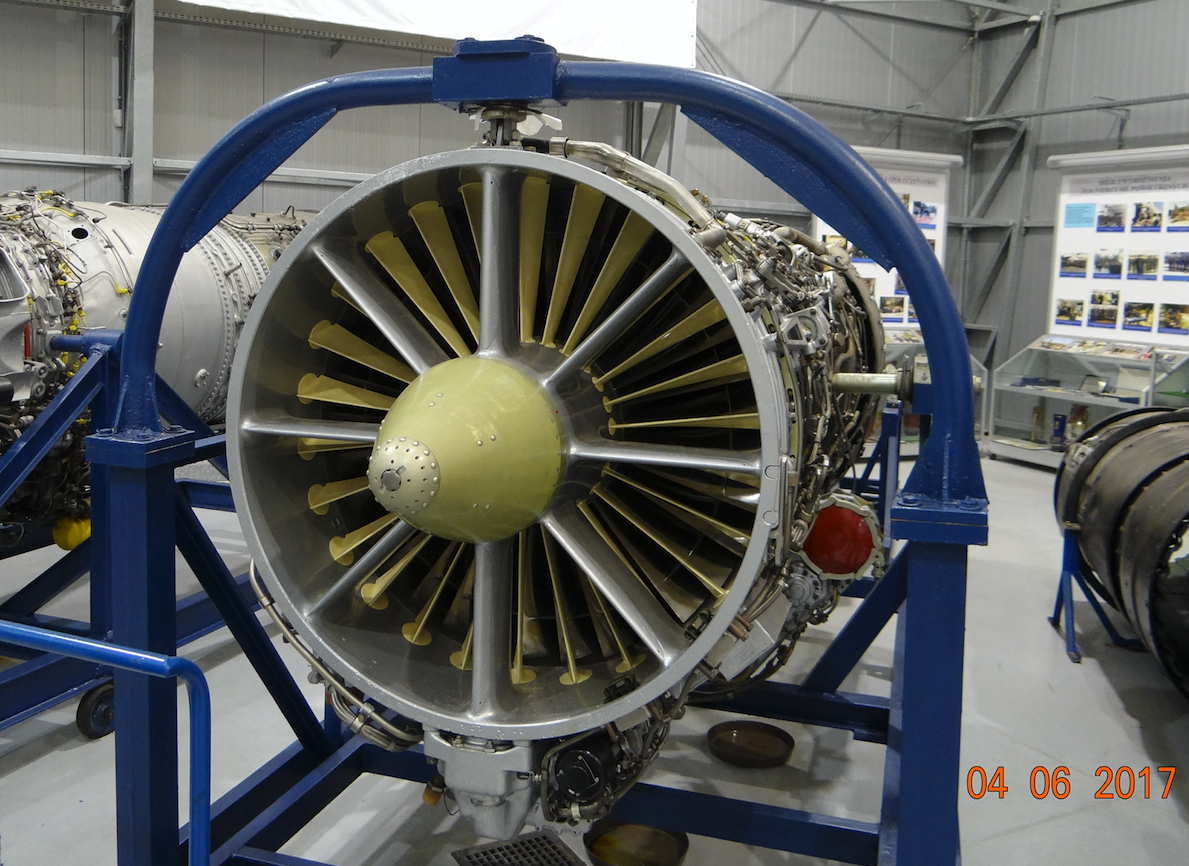
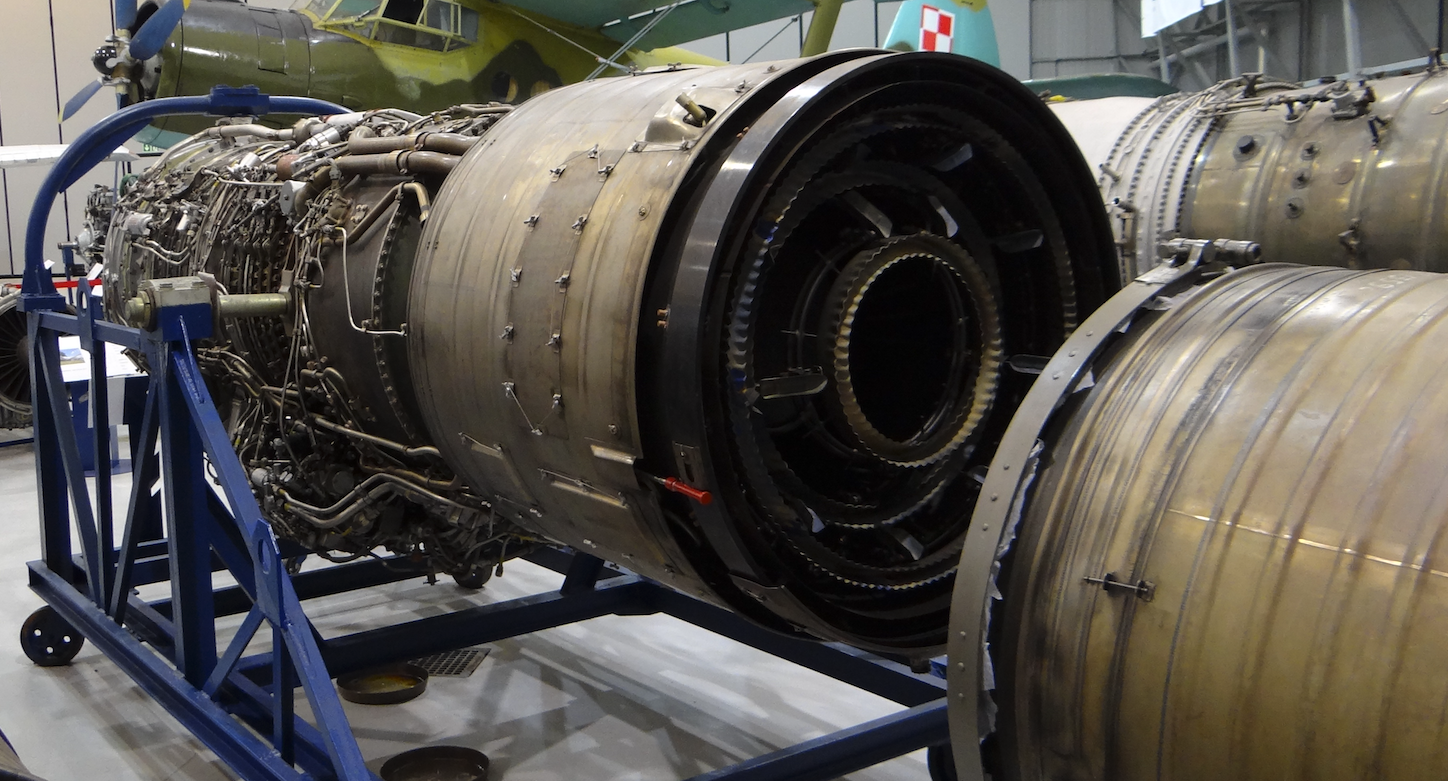
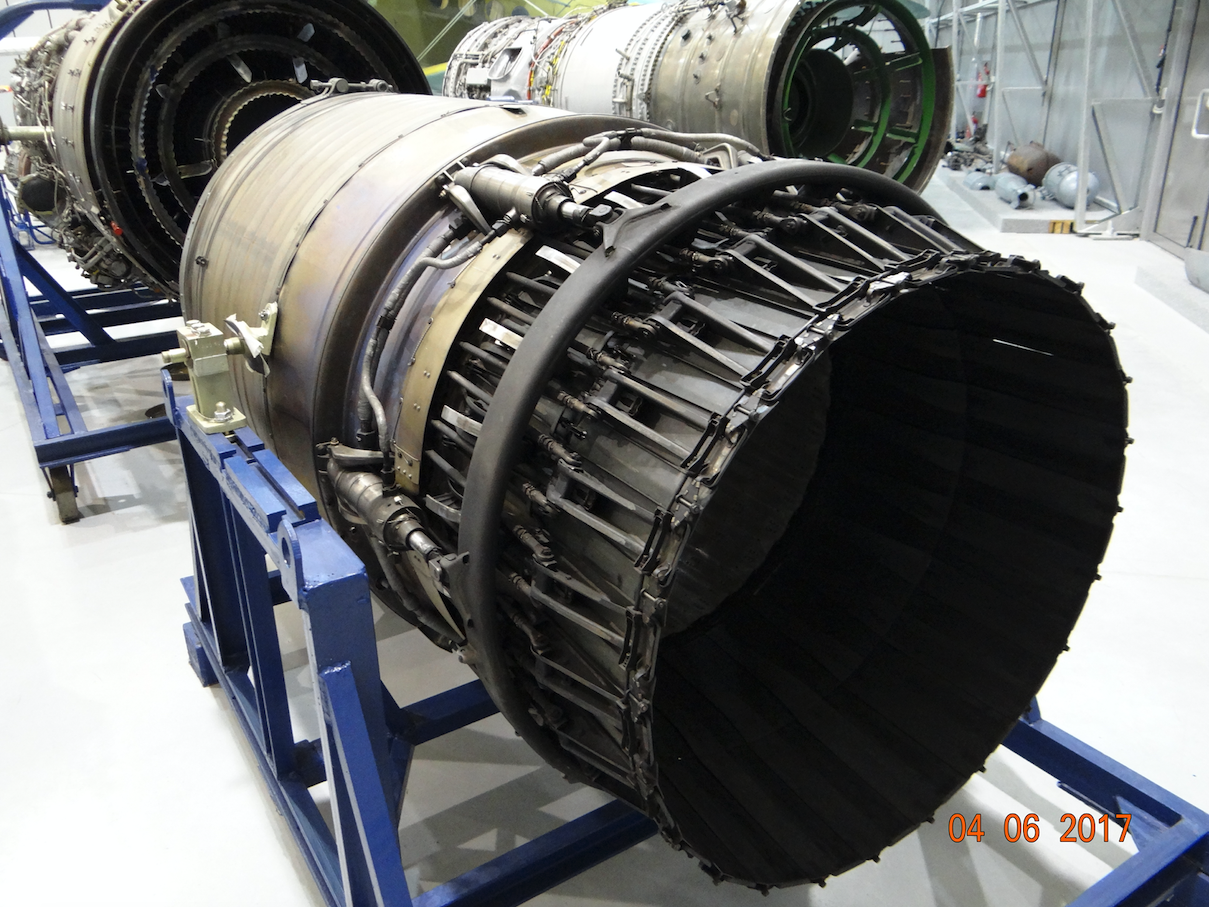
Painting Su-20 aircraft
Polish Su-20s were silver. Side numbers and inscriptions in red. At the end of operation, Su-20 aircraft received camouflage, and the side numbers were yellow.
Data T-T Suchoj Su-20
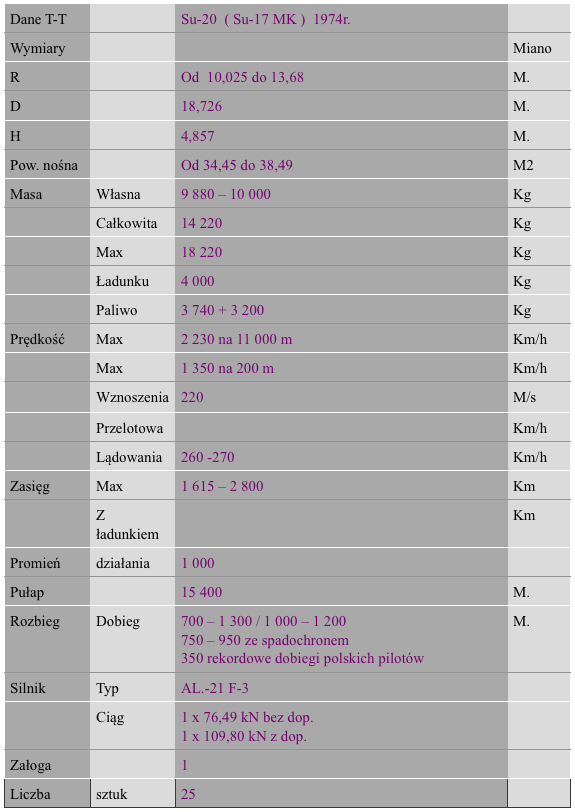
Written by Karol Placha Hetman
Kraków 2007-08-22
235 Section 1974-04-26
OKB Suchoj Su-20
Poland
Tally
Supersonic fighter-bomber plane, with variable-sweep wing (variable wing geometry). The first of its kind in the Polish Army (Polish Air Forces).
The Su-20 marking in Poland was as follows;
-
the first digit denoted the year of arrival in Poland,
-
the second digit denoted the quarter of the year of arrival in Poland,
-
the third month of arrival, but there were cases of rounding up,
-
the fourth digit was the last digit of the airframe serial number.
Tally
1 Su-20 (S-32 MK) No. 01/4241 No. 6601- Built in February 1974. Delivered 1974-04-26. The aircraft received nb 01. If the aircraft had survived to change the side numbers it would have nb 4241. Broken 1976-02-03, near the town of Kazimierz Biskupi. Pilot Capt. Jerzy Doliniec was killed. The disaster occurred as a result of aggregate failure and engine stalling. The failure occurred due to the fault of the manufacturer, who recognized his fault and provided a new aircraft as compensation.
2 Su-20 nb 02/4242 No. 6602 – Built in February 1974. Delivered 1974-04-26. After leaving the service, handed over to the Museum in Czyżyny (1997).
3 Su-20 nb 03/4243 No. 6603 – Built in February 1974. Delivered 1974-04-26. Crashed on 1987-09-07, near the Powidz lake. Pilot Maj. Andrzej Pawłowski (?) Successfully catapulted.
4 Su-20 nb 04/4244 No. 6604 – Built in February 1974. Delivered 1974-04-26. The front part of the aircraft was a teaching aid at the technical school in Oleśnica. Since 2010, it has been an exhibit at the Polish Aviation Museum in Czyżyny.
5 Su-20 nb 05/4245 No. 6605 – Built in February 1974. Delivered 1974-04-26. The aircraft operated until 1994-02-28, in (like most Su-20 aircraft) 7. BLB-R (Bomber Reconnaissance Brigade) in Powidz. Later, the unit evolved into the 7th PLBR (Bomb Reconnaissance Air Regiment). In 1994, the aircraft went to the Air Force Base in Mierzęcice, and then in 1995 to the Poznań Museum at the Citadel. Initially, he stood in front of the Citadel, and then at an outdoor exhibition in the Citadel. It is interesting that the plane from the beginning flew with the wings of another Su-20 with serial number 6604, although the beams under the wing had its own. In the unit, he received her markings in the form of an emblem on the fin and an emblem on the bow (the green color of seven indicates belonging to 2 squadron). The aircraft was restored in 2002. The aircraft serial number is 6605. The last board number was 4245, it was painted over SCHOOL for some time.
6 Su-20 nb 6130 No. 74930 – Built in December 1975. Delivered 1976. On 1986-03-10 (?) It was crashed at the training ground in Ustka. Pilot captain Czesław Gibaszewski catapulted successfully.
7 Su-20 nb 6131 No. 76301 – Built in 1976. Delivered 1976. The aircraft was decommissioned relatively early because it did not undergo renovation or repainting to camouflage. After serving, he was placed in the Museum of Polish Military Technology, Czerniaków Fort in Warsaw.
8 Su-20 nb 6134 No. 74724 – Built in October 1975. Delivered 1976-04-13. On 1995-05-31, at 10:56. wrecked in Młynica near Strzelin. Pilot captain Grzegorz Falent was killed.
9 Su-20 nb 6137 No. 74727 – Built in December 1975. Delivered 1976-04-13. On 1978-03-13, he snapped up at the start. The pilot was captain pilot Stanisław Walczak.
10 Su-20 nb 6138 No. 74728 – Built in December 1975. Delivered 1976-03-18. Used in 7. PLB-R in Powidz. Withdrawal from service 1997-02-28. In October 1999, donated to the museum.
11 Su-20 nb 6139 No. 74729 – Built in December 1975. Delivered 1976-03-18. Crashed at the training ground in Solec Kujawski. Pilot captain Ryszard Pawłowski Catapulted successfully.
12 Su-20 nb 6250 No. 74210 – Built 1975. Delivered 1976. After leaving the service in Czyżyny in the warehouse part dismantled since 2009. Intended as an exhibit for exchange.
13 Su-20 nb 6251 No. 74311 – Built 1975. Delivered 1976-04-09. Crashed 1990-08-01, over the training ground in Nadarzyce. Pilot por Jerzy Gruszczyński catapulted successfully. Author of many publications and aviation articles.
14 Su-20 nb 6252 No. 74302 – Built 1975. Delivered 1976. After serving at the Museum of Polish Military Technology, Czerniaków Fort in Warsaw. The plane is in camouflage.
15 Su-20 nb 6253 No. 74303 – Built 1975. Delivered 1976.
16 Su-20 nb 6254 No. 74304 – Built January 1976. Delivered 1976. On 1993-07-14, wrecked near Września. Pilot captain Robert Dudzik (?) Catapulted successfully.
17 Su-20 nb 6255 No. 74305 – Built 1976. Delivered 1976.
18 Su-20 nb 6262 No. 74312 – Built 1976. Delivered 1976. The plane spent 1,359 hours in the air. After serving, the aircraft was bought by one of Polish entrepreneurs. It was set on a pedestal as if it was rising into the sky, next to National Road No. 4 and a petrol station, in front of Tarnów. It became an advertisement for a mayonnaise producer. In 2004, the aircraft was put up for sale as part of the Great Orchestra of Christmas Charity. The entrepreneur from Częstochowa became its new owner, for around PLN 4,500. But he did not take away his property because he was discouraged by the costs of dismantling and transport. The plane was too close to the road and hindered its modernization. In 2007, the aircraft was dismantled and transported to Częstochowa on two lorries. On 28.03.2007-03-28 (Wednesday), Su-20 went into the hands of a passionate from Brzeziny.
19 Su-20 nb 6263 No. 74313 – Built in December 1975. Delivered 1976-04-09. Crashed 1978-05-22, near the Bednary alternate airport Pilot lieutenant Antoni Dziadowski (?) was killed.
20 Su-20 nb 6264 No. 74314 – Built in December 1975. Delivered 1976-04-09.
21 Su-20 nb 6265 No. 74316 – Built in December 1975. Delivered 1976-04-09.
22 Su-20 nb 7125 No. 74105 – Built in 1974. Delivered 1977-02-12. Handed over by the producer for a lost plane. Withdrawn from service on 1995-08-19. In 2012, the plane went to the museum in Dęblin.
23 Su-20 nb 6256 No. 74416 – Delivered in 1976. After service, as a private exhibit at the gas station on the S7 road, Grójec-Białobrzegi.
24 Su-20 – Delivered 1976.
25 Su-20 – Delivered 1976.
26 Su-20 – Delivered 1976.
27 Su-20 – Delivered 1976.
In Poland, 27 pieces of Su 20 were used, these planes were always stationed at the base in Powidz. The last copies were withdrawn in 1997.
Written by Karol Placha Hetman
